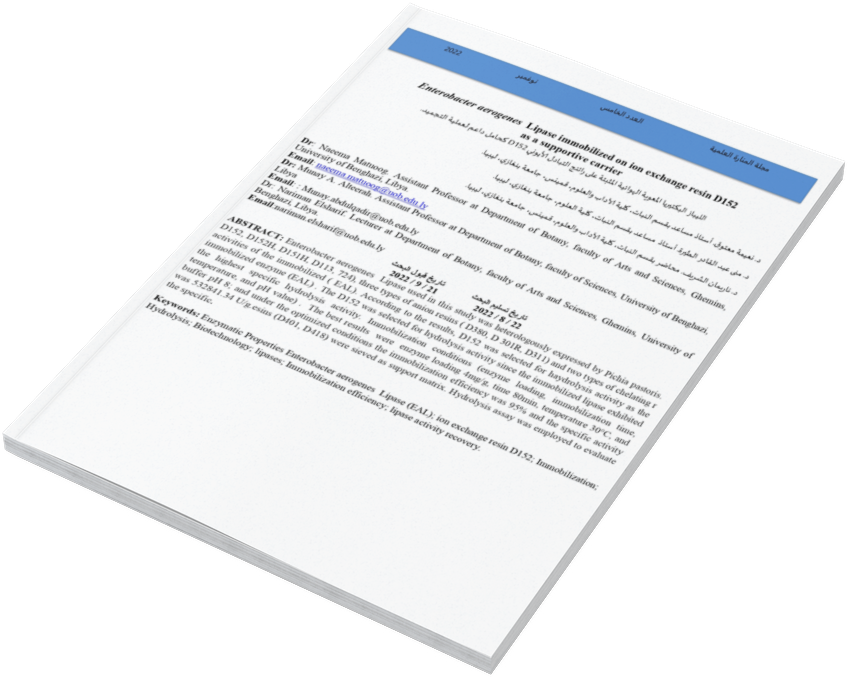Enterobacter aerogenes Lipase immobilized on ion exchange resin D152 as a supportive carrier
DOI:
https://doi.org/10.37376/asj.vi5.4130Keywords:
Enzymatic Properties Enterobacter aerogenes Lipase (EAL, ion exchange resin D152, Immobilization, Hydrolysis, Biotechnology, lipases, Immobilization efficiency, lipase activity recoveryAbstract
Enterobacter aerogenes Lipase used in this study was heterologously expressed by Pichia pastoris. D152, D152H, D151H, D113, 724), three types of anion resins ( D380, D 301R, D311) and two types of chelating r activities of the immobilized ( EAL). According to the results, D152 was selected for haydrolysis activity as the immobilized enzyme (EAL) . The D152 was selected for hydrolysis activity since the immobilized lipase exhibited the highest specific hydrolysis activity. Immobilization conditions (enzyme loading, immobilization time, temperature, and pH value) . The best results were enzyme loading 4mg/g, time 80min, temperature 30°C, and buffer pH 8; and under the optimized conditions the immobilization efficiency was 95% and the specific activity was 532841.34 U/g.esins (D401, D418) were sieved as support matrix. Hydrolysis assay was employed to evaluate the specific.
Downloads
References
Bertram, M., Manschot‐Lawrence, C., Flöter, E., & Bornscheuer, U. T. (2007). A microtiter plate‐based assay method to determine fat quality. European Journal of Lipid Science and Technology, 109(2), 180-185.
- Wang, H., Zong, M. H., Wu, H., & Lou, W. Y. (2007). Novel and highly regioselective route for synthesis of 5-fluorouridine lipophilic ester derivatives by lipozyme TL IM. Journal of biotechnology, 129(4), 689-695
- Yu, H., Wu, J., & Ching, C. B. (2004). Enhanced activity and enantioselectivity of Candida rugosa lipase immobilized on macroporous adsorptive resins for ibuprofen resolution. Biotechnology Letters, 26(8), 629-633.
- Liu, K., Zhao, G., He, B., Chen, L., & Huang, L. (2012). Immobilization of pectinase and lipase on macroporous resin coated with chitosan for treatment of whitewater from papermaking. Bioresource technology, 123, 616-619.
- Li, X., Huang, S., Xu, L., & Yan, Y. (2013). Improving activity and enantioselectivity of lipase via immobilization on macroporous resin for resolution of racemic 1-phenylethanol in non-aqueous medium. BMC biotechnology, 13(1), 1-9
- Salis, A., Svensson, I., Monduzzi, M., Solinas, V., & Adlercreutz, P. (2003). The atypical lipase B from Candida antarctica is better adapted for organic media than the typical lipase from Thermomyces lanuginosa. Biochimica et Biophysica Acta (BBA)-Proteins and Proteomics, 1646(1-2), 145-151.
- Sun, J., Jiang, Y., Zhou, L., & Gao, J. (2010). Immobilization of Candida antarctica lipase B by adsorption in organic medium. New Biotechnology, 27(1), 53-58.
- Dizge, N., & Keskinler, B. (2008). Enzymatic production of biodiesel from canola oil using immobilized lipase. Biomass and bioenergy, 32(12), 1274-1278.
- Sharma, R., Chisti, Y. & Banerjee, U.C. ''Production, purification, characterization, and applications of lipases''. Biotechn. adva.vol. 19, pp.627-662, 2001.
- Ferreira-Dias, S., Sandoval, G., Plou, F. & Valero, F. ''The potential use of lipases in the production of fatty acid derivatives for the food and nutraceutical industries''. Elect. J. Biotechn. 16(3), pp.12-12, 2013.
- Kappe, C. O., Shishkin, O. V., Uray, G., & Verdino, P. (2000). X-ray structure, conformational analysis, enantioseparation, and determination of absolute configuration of the mitotic kinesin Eg5 inhibitor monastrol. Tetrahedron, 56(13), 1859-1862.
- Bradford, M.M. ''A rapid and sensitive method for the quantitation of microgram quantities of protein utilizing the principle of protein-dye binding''. Anal. biochem. vol. 72, pp.248-254,1976.
- Jaeger, K.E. & Reetz, M.T. ''Microbial lipases form versatile tools for biotechnology''. Trends in biotechn. vol. 16, pp.396-403, 1998.
- H Jurado, E., Camacho, F., Luzón, G., Fernández-Serrano, M., & García-Román, M. (2008). Kinetics of the enzymatic hydrolysis of triglycerides in o/w emulsions: study of the initial rates and the reaction time course. Biochemical Engineering Journal, 40(3), 473-484.
- Sörensen, M. H., Ng, J. B., Bergström, L., & Alberius, P. C. (2010). Improved enzymatic activity of Thermomyces lanuginosus lipase immobilized in a hydrophobic particulate mesoporous carrier. Journal of colloid and interface science, 343(1), 359-365.
- Svendsen, A. (2000). Lipase protein engineering. Biochimica et Biophysica Acta (BBA)/Protein Structure and Molecular Enzymology, 1543(2), 223-238.
- Khan, N.A., Jung, B.K., Hasan, Z. & Jhung, S.H. ''Adsorption and removal of phthalic acid and diethyl phthalate from water with zeolitic imidazolate and metal–organic frameworks''. J. Hazardous Mat., vol. 282, pp.194-200, 2015.
- Abian, O., Grazú, V., Hermoso, J., González, R., García, J. L., Fernández-Lafuente, R., & Guisán, J. M. (2004). Stabilization of penicillin G acylase from Escherichia coli: site-directed mutagenesis of the protein surface to increase multipoint covalent attachment. Applied and environmental microbiology, 70(2), 1249-1251.

Downloads
Published
How to Cite
Issue
Section
License
Copyright (c) 2023 Almanara Scientific Journal

This work is licensed under a Creative Commons Attribution-NonCommercial-NoDerivatives 4.0 International License.




